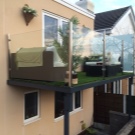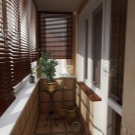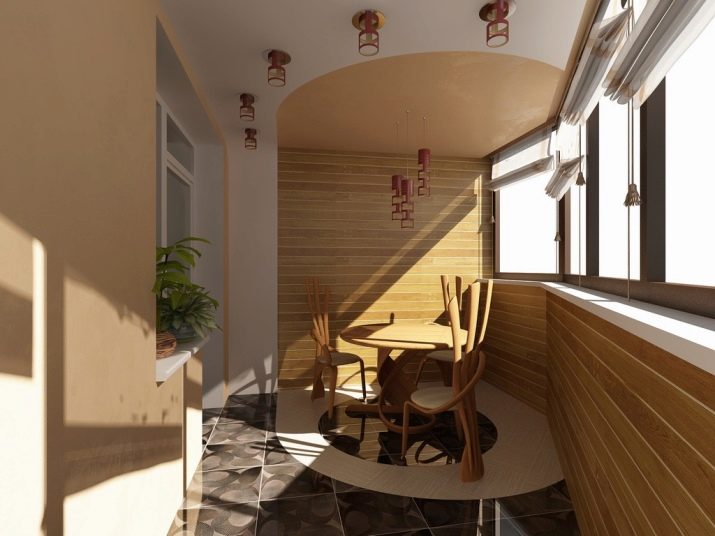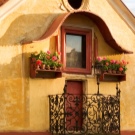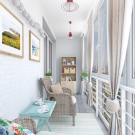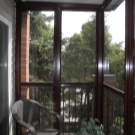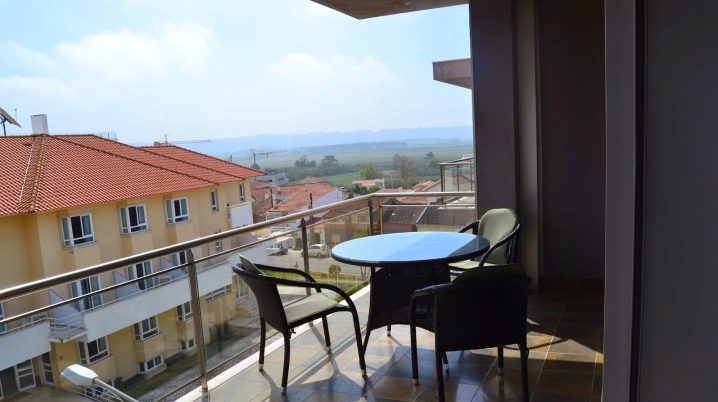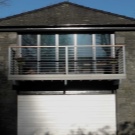Loggia
We owe the appearance of loggias and balconies to medieval fortresses. The very first can be found at the city gates or towers of the European fortifications of the XIII century. Over time, these successful architectural finds, acquiring grace and lightness, migrated to the walls of residential houses.
A balcony is a platform that extends beyond the facade and is attached in various ways to the wall of the building. The outer perimeter is fenced.
Loggia - room, built into the building. In the classic version, one side remains open, in the newest projects - two or three. The front part can be decorated with a colonnade, arcade or parapet. The foundation of the loggia is always part of the supporting structures.
Like all new items, initially these constructive elements were more decorative in nature, the owners did not stint on their decoration and decoration. To amaze neighbors with an unusual form, decoration was a matter of honor, therefore such terraces were intended exclusively for rest and communication in the open air.
Mass construction has made balconies and loggias accessible to all segments of the population.In addition to single models located at a distance, there were paired, with partitions, designed for several apartments. They lost in aesthetics and simplified the plasticity of the facades, but gained in the possibility of more practical use. They arrange mini gyms, greenhouses, classrooms, combined with kitchens, store unnecessary trash.
Modern technologies and planning have practically erased the external signs between these two different types of structures. The ability to distinguish loggias and balconies from each other in this situation is important when calculating the usable area of an apartment, repairing, re-planning, finishing, buying or selling a home.
In pursuit of style
Depending on the climate, the uniqueness of the national culture, the balconies and loggias acquired features characteristic of their countries. The most successful were examples of style or town planning norms. And they all have taken root in Russia with less or more success.
- The classic Italian loggia / balcony is distinguished by a variety of shapes, sizes, and a wealth of decorative techniques. For fences, an elegant forging motif is used.
- French loggia / balcony - found in buildings of Soviet construction. The loggia is distinguished by its small size and decorative, rather than functional purpose. By analogy with the French balcony, which has no protrusion, and the door is simply fenced with twisted bars.
- In Spanish style - the terrace has a small rectangular, in some cases square shape. The decoration and decor are strict, concise. As a railing around the perimeter, a modest lattice or concrete parapet.
- In the American style - today it is more often used in individual construction or rather widely in the construction of tourist complexes and hotels.
Loggias and balconies of this type are located almost along the entire perimeter of the building, sometimes they have light jumpers. The railing is usually lower than in the classic versions.
- In Portuguese style (veranda) - a type of loggia, can be an open or closed area on the first floor of the building, is used exclusively in low-rise construction, in the southern areas this room is part of the apartment. It is widely used in children's and sanatorium facilities.
- Swedish balcony - has a narrow rectangular removal of the facade, fencing - metal bars. Modern standard Russian balcony is one of the prototypes of the Swedish.
In the middle and more northern latitudes, the protrusion is small so as not to limit natural lighting, both on the balcony itself and in the room behind it. Indeed, besides the upper floors in an apartment building, there is another one above each balcony, from which a shadow is formed throughout the day. Loggias give even more blackout, therefore in houses in the north they are much less than in the south, where people are forced to escape from the heat.
It was not by chance that in the Soviet period, at first, high-rise buildings of the southern republics were equipped with loggias. In the 70s such a planning decision became one of the essential components of apartments with improved planning throughout the USSR. Now these buildings are called houses of the Brezhnev period.
Interestingly, depending on the climate zone in the Soviet Union, a room was also determined, to which a balcony or loggia should be attached. And now in temperate climates, they coexist with a common room or kitchen, in hot regions - with a bedroom. Nowadays, with the advent of climate control equipment, the forms of balconies and loggias have become more diverse and depend less on the place of registration.They can be in the form of familiar rectangles, rounded, angled, side. Elongated and triangular, in the form of an arc, polygon or arrow-shaped.
Design differences
In modern mass residential development, the base of any balcony or loggia is reinforced concrete slabs (GOST 25697-83). Depending on the project, they can be solid, multi-hollow or ribbed; cantilever or beam. The difference of application is that for loggias plates with reinforcement, increased margin of safety are used. For the balconies do not apply hollow.
The upper front surface of the plates for open structures provides for a slope (from external walls) of at least 3%. It is necessary for the flow of water during precipitation. It is allowed to use slabs without a slope of the upper surface, if its creation is already provided on the construction site or glazing is initially planned. By the way, in Moscow, since 2001, all new houses erected by the city are being commissioned already with glazed balconies and loggias.
It is worth considering that with glazing the illumination is reduced by an average of 15-20%.
Table of standard sizes of balconies and loggias depending on the type of building:
| Building type | "Khrushchev" | "Brezhnevka" | Panel | Blocky | Loggia 3 m | Loggia 6 m |
| Length, m | 2,8 - 3,1 | 2,4 | 3,1 | 5,640 | 3,0 | 6,0 |
| Width, m | 0,65 -0,8 | 0,65 - 0,8 | 0,7 | 0,7 | 0,7-1,2 | 0,7-1,2 |
| The minimum height of the parapet, m | 1,0 | 1,0 | 1.2 (height from the parapet 1.45) | 1.2 (height from the parapet 1.43) | 1,0 – 1,2 | 1,0 – 1,2 |
The difference in values reflects climatic zones. According to SNiP 2.08.01-89, the sizes of balconies, loggias in the regions of the Far North are only 0.6 m wide, and 1.2 m in the southernmost regions of Russia.
Loggia designs:
- built-in has deaf bearing side barriers- “cheeks”, on which the loggia panels rest (stack):
- portable - is completely behind the facade of the building. Side walls, perpendicular to the facade, can be load-bearing or mounted;
The side walls are carrying at the loggias only in buildings of average height. To ensure uniform and simultaneous draft with the whole building, behind the facade line they are fixed on the floor bearing plates. In the modernized series of houses, for example, P-44T and P-44TM, erg type loggias rely only on one facade plane, due to which the load capacity of a part of the plates is reduced. According to its characteristics, such balconies are comparable to a balcony.
- a loggia-balcony — most of it is “buried in a building”, the second, open on three sides, stands for the ends of the side fences. The ceilings are mounted, as in remote loggia designs.
There are increased requirements to the base of loggia-balconies, therefore panels or balcony plates with a reinforced facade edge are used as floors.
In the modernized series of houses, for example, P-44T and P-44TM, erg type loggias rely only on one facade plane, due to which the load capacity of a part of the plates is reduced. According to its characteristics, such balconies are comparable to a balcony.
Unlike a loggia, fixing balconies differs in a variety of options:
- on the girders (brackets or beams) - girders mounted in the facade wall, hold onto the balcony panel;
- with a cantilever attachment - the principle is similar to a beam: consoles reinforced into the wall, hold the balcony slab. The visible part of the consoles can be in the form of a simple beam, in the form of a curl or a sculpture.
- on reinforced concrete slabs (one of the most common types) - pinching the balcony slab into the construction of the outer wall (up to 40-50 cm). In brick houses, welding with steel anchors is added to mortgage bridges of reinforced concrete.
- on props or columns - the name speaks for itself: the protrusion supports supports made of wood, metal or reinforced concrete.There are in our days. In modern buildings such balconies are usually spacious.
Sometimes mixed mounts are used. For example, laid beam-console or beam-rack construction.
From the relatively new ways of fixing the balcony can be identified:
- Attachment - mounted with solid for all floors of the side supports. Front racks facilitate the load on the facade of the house. A foundation is necessarily built under the supports;
- attached - the most economical, fixed with the help of support runs or bearing consoles, and part of the load is transferred to the racks, based on the "point" foundation;
- hinged - a special construction is created, which seems to be hung on the wall. No need to worry about the foundation.
The most "fragile", judging by the discussions in social networks and blogs, is the console balcony in the panel "Khrushchev" with thin walls. Most of them today require either a major overhaul or replacement. The ideal option for secure mounting is the location of the balcony slab strictly in the center of the load-bearing wall.
There were also ultranovye - combinatorial solutions.Their distinctive feature is that the balconies are a removable cell with a railing or glass blocks, completely ready for use. This facilitates not only the process of erection of the building, but also very convenient for the repair and restoration, which can now proceed without the eviction of residents.
With this technology, you can easily transform the look of the whole house, changing the balconies, for example, rectangular to semicircular.
Wooden version
In frame wood, cottages and houses from rounded timber, similar technologies and designs of the balcony are used: beam-rack or beam-console.
When the beam-cantilever for bearing beams use solid wood with an impressive diameter, which will be able for many years to hold heavy construction. To increase the rigidity of the cantilever part, install the struts. They can be both wooden and metal. Forging goes well with wood, but in places where metal contacts a tree, dark rust stains may appear after a while.
Beam-cantilever mounting method exists in two versions.When the first balcony is supported on the floor beams passing through the outer wall. However, according to SNiP 11-25-80, it considers this a prohibited technique. And all because the node joining beams and walls in the open balcony structures may begin to rot due to guaranteed soaking. Over time, this can be a threat to the destruction of the house. Sealants do not provide reliable protection of these components during long-term operation.
The best solution - when cantilever logs or bars are a continuation of the outer walls, the interior, experts warn from time to time, cannot be used for these purposes. The exhaust beams must create a monolithic structure of the base. With the usual rectangular balcony shape, the console is joined by a beam, the draft flooring is laid and fixed. Extreme floor joists are attached to the frame racks of the wall, and the rest on the floorboards - battens.
The successful and beautiful decision with a console bar from which wreaths descend downwards on decreasing. Such a balcony structure in addition to aesthetics gives additional rigidity.
To protect the main anchorage sites and the terrace itself from precipitation, a canopy is constructed above the balcony.Sometimes its role is performed by a roof above the landing. If this needs to be done between the two slopes of the roof, in the gable part, then lengthen the ridge. At the location of the balcony under the extended overhang, install rafter legs.
Beam-rack mount is used for the construction of large balconies, as the standard length of cantilevered logs, bars and beams is not more than 2 m. The role of the pillars in this design is usually performed by log poles or bars.
A wooden house inevitably shrinks, especially quickly these processes take place in the first years. Due to the difference in weight and load, the racks of the balcony sag much more slowly. To avoid skewing, screw mechanisms are installed in the upper or lower part of the supports. With the help of them you can adjust the height of the balcony, adjusting it to the current position of the house.
Under the balcony sometimes place a veranda, parking for the car, porch, while the balcony can perform the function of the visor - in this case, the flooring is dense. If there is a free, unoccupied space under the open balcony, the decking can be placed through a small distance from each other to drain water.
Loggias in wooden houses are most often built using part of the attic. Therefore, all works to one degree or another are connected with the construction of the upper floor, the floor of which will serve as the foundation, and the roof, the slopes of which will serve as side barriers of the loggia. Railing is provided only on the front line. Their height must be at least 1 m.
Loads
Reinforced concrete slabs without additional supports (pinched) best of all withstand compression, slightly worse than bending or stretching, do not tolerate - torsion and shear. Therefore, the design, while complying with all norms and technologies, is durable, but it does not respond well to shocks or long-term storage of heavy objects near fences. This property should be taken into account when choosing a glazing.
With the arrangement and insulation of the loggia can withstand greater loads than the balcony.
The allowable weight for slabs in apartments is 150 kg per square meter. At the balcony of this figure, in any case, should be less, because its plate is fixed only on one side, and not on four, as in any room.
The norms of SNiP 2.01.07-85 * indicate the permissible loads:
- uniform along the outer perimeter of the balcony - 400 kgf / m²;
- uniform over the entire area of the balcony slab - 200 kgf / m².
If we subtract the weight of the fences from these figures, take into account the wear of the slab, the front wall and the fastener, then a little more than 100 kg will be accumulated. It may be that the balcony in its original form can only bear the weight of the tenants, for more it is not designed.
The calculation of permissible loads determines the prohibitions on changing the configuration of the balcony opening, work on the unification of the balcony with the room. For example, when cutting out a balcony opening to a rectangle in prefabricated houses with thin walls (350-510 mm), the plate of the balcony itself inevitably begins to sag, for a strong attachment it lacks gravity from above.
The collapse of the facade is fraught with the expansion of living space due to the balcony in the "Khrushchev" with load-bearing walls with a thickness of 300-350 mm. They use a tongue-and-groove fastener, which has a minimum safety factor, as a connecting element.
However, balconies are equipped and they do not collapse. This is because there are safety margins for the bearing and optional structures of each series. Reliability coefficients take into account the possibility of overlapping, number of storeys, type of buildings.
Accurate calculations can only provide specialists design organizations and BTI. Moreover, glazing and redevelopment are possible only with the approval of the Bureau.
Property for two
The property rights to the balcony are divided by law between the housing and public utilities and the owner of the privatized apartment. Housing and communal services own the bearing walls and the plate, the tenant - everything that is on this plate: a parapet or a handrail, a peak, a glazing system, etc. In the event of the destruction of the slab, the owner of the housing has the right to apply for a major overhaul in the housing and utilities sector, at their expense (except in cases of improper operation). The basis is the Order of the Government of the Russian Federation of 13.08.2006 N 491.
The law provides for any permitted changes in the layout or appearance of balconies and loggias. The principle of prohibited actions is reduced to three points:
- not to destroy the design of the bearing walls, so as not to lead to the destruction of the facade;
- do not violate fire safety standards (associated with the use of combustible materials and heating systems);
- do not create inconvenience and danger to neighbors or passers-by (especially important for glazing and extension).
For unauthorized glazing or redevelopment (CAO RF Art. 7.21), the owner is fined and ordered to dismantle, in extreme cases - the sale of the apartment.With social hiring according to the Housing Code of the Russian Federation, in addition to a fine, eviction is threatened.
Today, with unified solutions for urban development, the exterior is taken into account, but people are more concerned with square meters. Real estate sellers and the Bureau of Technical Inventory (BTI) are interested in their formal increase, buyers and tenants are in lowering. And all because the price of apartments, taxes, payment for heating directly depends on the living space, which includes balconies and balconies:
- the area of the balcony is added to the total with a reduction factor of 0.3;
- loggia area is considered with a reduction factor of 0.5
In the case of the official combination of a balcony or loggia with a room, their area is added in full, without a reduction factor. When installing central heating on the loggia, it will be taken into account already as part of the total living space.
Heating on the balcony is strictly prohibited! All changes should be reflected in the BTI documents and certificate of ownership.








